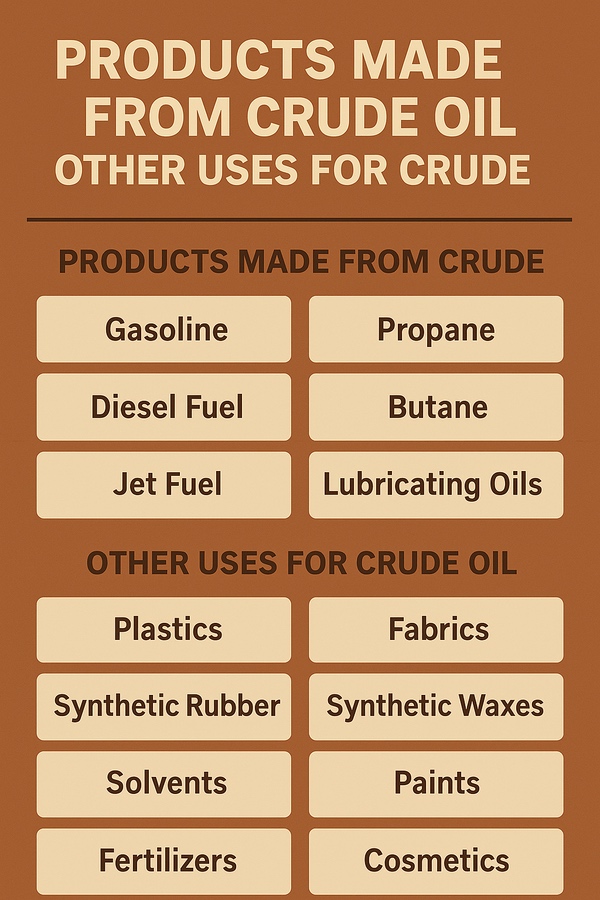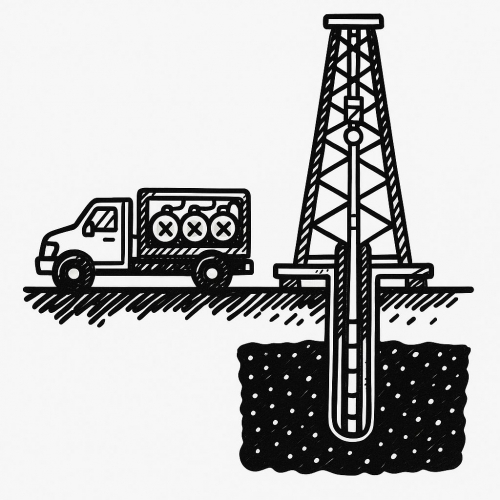Crude oil is often thought of solely as the source of gasoline or diesel. However, this natural resource is much more than a fuel provider. Crude oil is the foundation for thousands of everyday products and materials. From the plastic water bottle in your hand to the tires on your car — crude oil has shaped modern life in profound ways.
This article explores the two major categories:
- Products Made Directly from Crude Oil
- Other Everyday Uses for Crude Oil Derivatives
I. Products Made Directly from Crude Oil
Once extracted from underground reservoirs, crude oil is transported to refineries where it's separated into various components through a process called fractional distillation. The result? A spectrum of fuels and oils, each used for specific applications.
1. Gasoline
Used primarily as fuel for internal combustion engines in cars, motorcycles, and light trucks. Gasoline is one of the most recognized end-products of crude oil.
2. Diesel Fuel
A heavier fuel used in trucks, buses, ships, and industrial machinery. It provides better fuel efficiency than gasoline.
3. Jet Fuel
Specially refined kerosene used to power aircraft engines. It must meet strict performance and freezing point standards.
4. Heating Oil
Used for residential and commercial heating, especially in colder climates. It’s similar to diesel but formulated for boilers and furnaces.
5. Propane & Butane
These are liquefied petroleum gases (LPG) derived from natural gas processing and crude oil refining. Commonly used in cooking, heating, and outdoor grilling.
6. Lubricating Oils / Motor Oils
These oils reduce friction in engines and machinery, extending the lifespan of equipment and improving efficiency.
II. Other Uses for Crude Oil Derivatives
Beyond fuels and lubricants, crude oil serves as the chemical base for petrochemicals—key building blocks for materials we use every day.
1. Plastics
From food containers and toys to phone cases and medical devices, plastics are synthesized from petrochemical compounds such as ethylene and propylene.
2. Synthetic Rubber
Used in car tires, footwear, seals, and gaskets. Crude oil derivatives like styrene and butadiene form the backbone of synthetic rubber.
3. Solvents & Paints
Paint thinners, adhesives, and cleaners are made using crude-derived solvents like toluene and xylene.
4. Synthetic Fabrics
Materials like polyester, nylon, and acrylic originate from crude oil. These are widely used in clothing, upholstery, and outdoor gear.
5. Carpeting & Furniture Foam
Foam padding and carpeting are made with polyurethane derived from petroleum-based chemicals.
6. Cosmetics & Personal Care Products
Lipsticks, creams, shampoos, and lotions often contain mineral oils and waxes refined from crude oil.
7. Fertilizers
Crude oil powers the production of ammonia, a vital ingredient in nitrogen-based fertilizers used in global agriculture.
8. Medical Supplies
Disposable gloves, bandages, syringes, IV bags, and other essential hospital items are made from plastic polymers derived from crude.
Why This Matters
Understanding the widespread use of crude oil is essential in today’s energy and sustainability discussions. It reminds us that oil is not just about fuel — it’s also about materials, convenience, medicine, and global agriculture.
As the world transitions to greener alternatives, developing substitutes for these petroleum-based products remains one of the biggest challenges in reducing fossil fuel dependency.
Crude oil powers our vehicles, heats our homes, and enables the production of everyday goods that define modern civilization. Whether you're wearing a polyester shirt, flying in a jet, or turning on your heater — crude oil likely played a role.
The next time you hear about oil prices or energy policy, remember: it’s not just about fuel. It’s about the fabric of our daily lives.


%20(1).png)



